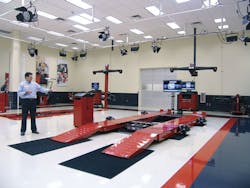Should the retail tire store of the future cater to changing consumer expectations? Certainly. Does the store owner have to reinvent the wheel to do so? No.
According to Hunter Engineering Co., however, the store of the future should focus on four basic design and procedural concepts:
- the facility itself;
- the process of welcoming customers into the store and keeping them engaged;
- technology, which includes equipment; and
- information integration.
“The dealer’s customers are looking for information and not so much a sales presentation like they might have looked for in the past,” says Beau Brauer, executive vice president. “If you believe that customers are really there to gather information, gather choices and make choices based on the information they’ve collected, then this concept really fits.
“It’s not really a solution in search of a problem. This is really what we think is changing in the buying behavior.”
The future is now
Brauer says Hunter has a personal stake in only one quarter of the design process, the technology part. Nevertheless, the company wants the independent tire dealer to succeed, and believes re-evaluating store designs and procedures will help everyone from the customer to the dealer to the supplier.
“We can make suggestions and share ideas we think are useful. We can bring ideas from one part of the industry we work with, like car dealers, and suggest elements that could be applicable in the tire dealer world (see “Customer flow”). But the facility is not part of our jurisdiction. That is really at the discretion of the owner.”
The process of welcoming each customer should be consistent, he says. “Managing the process... and improving it to make the customer experience better and better each year is something dealers are thinking about.”
Integration is “probably the last step for tire dealers, but definitely on everyone’s mind,” says Brauer. “If you look to certain portions of the industry, such as car dealers, they are getting away from paper processes, and moving to digital collection tools and communication tools.
“There’s a lot of handwork still happening at the counter. The hope is that after the technology is able to reduce it, you can integrate (all the information) so no more... double and triple work is required.”
As for technology, equipment needs to be more than efficient and reliable. “Equipment and technology in the dealership is an important choice because it defines how productive your shop can be,” says Brauer. “But sometimes, equipment also needs to help convey a technical message to a customer.
“If the printouts or outcomes of the equipment can be shown to a customer to help the customer make an informed decision or have an appreciation for what work was performed, they are nice enhancements to the business.”
Customer flow
Hunter worked with Autoplan Plus Inc. CEO Gordon Manock to come up with a design for car dealerships based on the premise that only 12% of a car dealer’s customers walk in the front door to look at new vehicles. The goal was to try to funnel the remaining 88%, who are visiting the dealership for service, from the service entrance into the showroom, where they can look at new vehicles.
The design flow has customers driving into an inspection lane for tire, brake, battery, tire tread and emissions inspections. The vehicles are then directed to oil change lanes or full service lanes while the customer is invited to the showroom to see the new vehicles, which already can be seen through the glass walls separating the service area from the showroom. If the car dealer wants to improve tire sales, he may invite the customer to visit a separate tire shop, something that can be added to the service area.
Tom Settle, Hunter’s director of training, says customers who are in for a general oil change or tire rotation are billed out immediately. If they were expecting high-pressure sales tactics, this helps alleviate any potential animosity. Then the service manager will discuss what the inspection revealed with the customer; that may include letting the customer know what the vehicle’s trade-in value is.
Along the way, there is a lot of personal contact with the customer. ■
To see a schematic of the shop design, click here.




